Pick
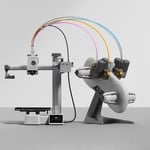
- Fast, with self-calibrating smarts
- High-uniformity prints
- Beginner-friendly experience
- Purge wiper rattles and can fail
- Laggy display and minor UI bugs

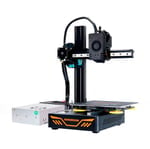
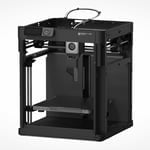
Ease of assembly, use, good quality on and offline documentation, and overall print quality are the considerations we have in mind when we think of the ideal 3D printer for beginners. Enough to yield good prints, with minimal hand-holding to get familiar with the process.
After countless hours of using, printing, and tinkering with a large selection of desktop 3D printers, followed by no small amount of deeper research, soul searching, and debating among our editorial team, we’ve concluded our recommendations for the best beginner 3D printers. Read on for deets on the three we’d recommend.
When taking your first steps into 3D printing, you’ll want a machine that is reasonably affordable, goes a little beyond the basics in terms of comfort features and print success systems, has clear instructions, a simple assembly process (if any), and – ideally – a large and supportive community behind the device to help out when you get a little lost.
Assembling a beginner 3D printer has gone from a box of parts and complex instructions on online communities to semi-assembled machines with a few steps and somewhat obtuse instructions to the fully-assembled, near-appliance-like 3D printers that are popular today. The best manufacturers have detailed wikis that answer most questions that could come up, but an active online community is also valuable to help novices navigate their newfound world with troubleshooting tips and other advice.
Overall, you’ll want a smooth experience from your 3D printer out the gate that allows you to get printing with minimum fuss. Both hardware and software play a role here: a good beginner 3D printer takes the load off early calibration and has a functional and intuitive interface. Effective nozzle probing that takes the onus off first layers and ample part cooling combined with software that makes tweaking print speeds and adjusting offsets easy are ideal for newcomers.
The printers in this list aren’t guaranteed to give you a trouble-free first chapter in 3D printing, especially if you’re looking for the cheapest way to dip your toe in, but when we have friends or family looking to get started with the hobby, these are the machines we point them to.
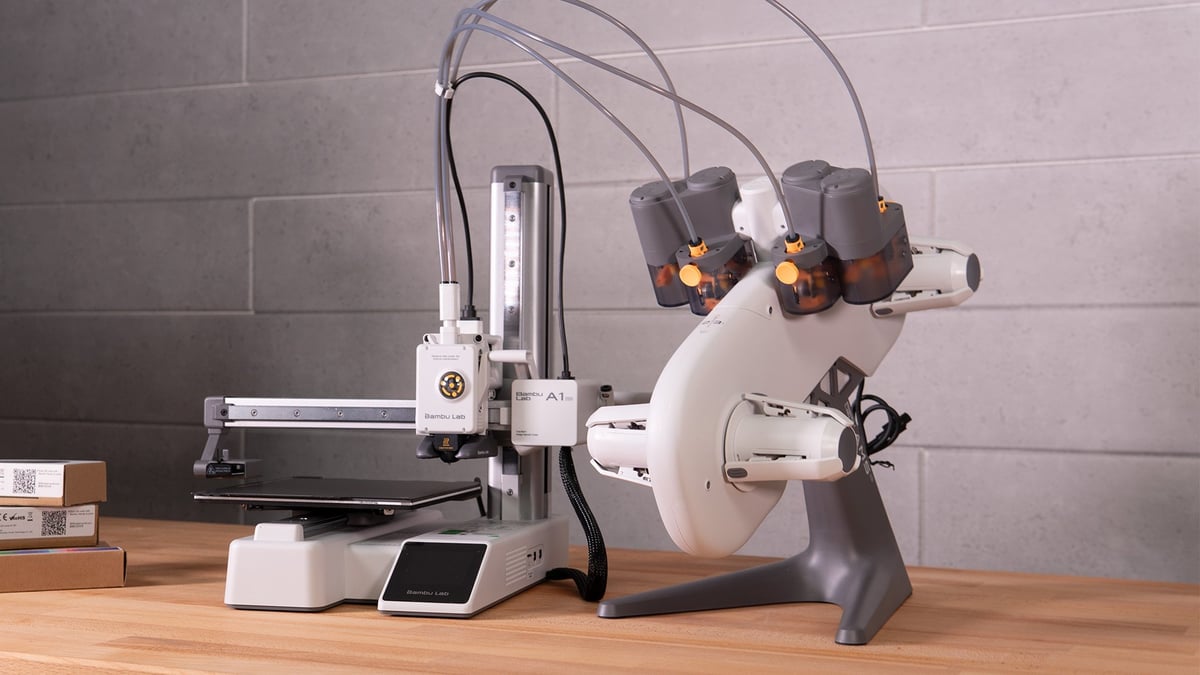
Bambu Lab’s A1 Mini was something of a surprise on its release. The company’s initial printers cleared the way for an absolute flood of cube-like CoreXY machines into the market, and so a cantilever-style bed slinger felt like a step backward to some. Bambu Lab, clearly, had decided it wanted a true budget offering with the brand’s patented appliance-like ease of use, and it delivered.
The linear rail-touting A1 Mini is small, with a build volume of just 180 x 180 x 180 mm, but nixing 76 mm from Bambu Lab’s larger models will get you a small form-factor 3D printer packed with Bambu Lab smarts for just $299. That means a machine that will self-calibrate, pull over-the-air updates, and self-diagnose an array of problems before spitting out an error code for you to consult the manufacturer’s extensive wiki. All while being a fast little machine that consistently delivers impressive quality in its prints.
The A1 Mini is, in a word, simplicity. That’s only built upon by Bambu Lab’s MakerWorld repository that lets the manufacturer’s users print in one click – and does so without pre-compiled G-code that malicious actors could use to harm end users. Designers simply provide slicing rules for their models, but the actual slicing happens in the cloud before downloading to your machine and getting to work.
Potential buyers should be aware that it’s not quite as polished as the company’s other offerings: we found the interface a touch laggy and some minor bugs in the UI, as well as the odd misspelled word. These are things we largely wouldn’t have batted an eye at with other manufacturers, but caught us off guard coming from Bambu.
These compromises are few and far between and well worth bearing for the savings and variety of quality-of-life features that come with the machine. A high-quality camera for remote monitoring, a (admittedly finicky) nozzle wiper, and – perhaps most importantly – a hot end that allows for toolless swapping, making it trivial to change nozzle sizes for fast or highly detailed prints. As if that’s not enough, it’s also compatible with Bambu Lab’s AMS Lite: an automatic material system that lets users print with up to four materials for stunning multi-material prints – but unfortunately, not flexibles like TPU.
All told, the Bambu Lab A1 Mini is the ideal beginner 3D printer and a machine that we have recommended to friends getting into the hobby.

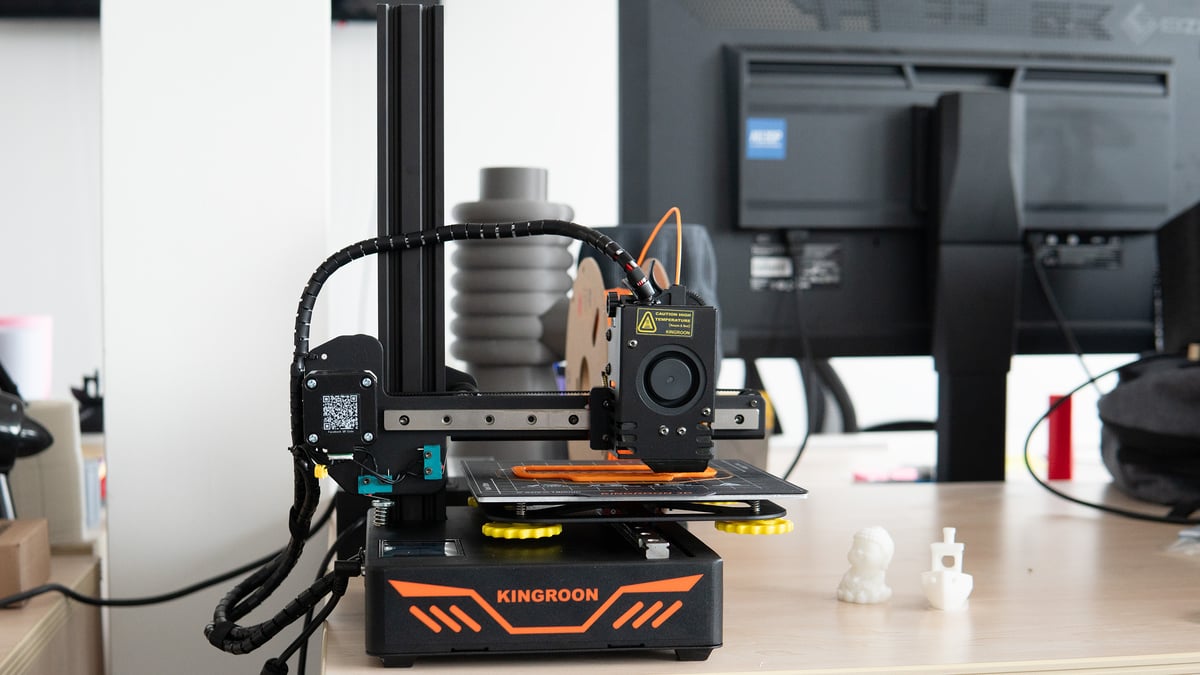
If you’re looking for a no-frills system to dip your toe into 3D printing for as little cost as possible, this is what you probably want. For about $140, you can get yourself a very tidy beginner 3D printer from Kingroon: the KP3S 3.0. Kingroon is a rather inconspicuous name in 3D printing, but its affordable and understated 3D printers have become something of a community favorite.
The KP3S series is comprised of linear-rail touting cantilever systems with build volumes of 180 x 180 x 180 mm. Linear rails are generally considered more reliable and longer-lasting for motion systems than more typical V-slot wheels but require more maintenance in the form of reapplying lubricant. They can also be pretty expensive, which is why it’s so surprising to see at low price points. That doesn’t mean the maintenance is especially demanding, though. It’s an easy, occasional process – even for a beginner – to keep a quality motion system in good repair.
It’s worth noting that the KP3S 3.0 is the only printer on this list that requires some assembly, coming flat-packed with the X-axis and base detached, and the lead screw stowed safely in a protective tube. Assembly is straightforward, with illustrated instructions that should make it easy for anyone to put a 3D printer together for the first time. There are a few other quirks about this printer – mostly involving endstops – but nothing that couldn’t be remedied with some simple tweaks. An amount of involvement and learning that we think is well worth the price. Check out our Kingroon KP3S 3.0 review for all the details and a solution or two.
Kingroon’s KP3S series comes in four models, with the KP3S 3.0 being the most affordable at ~$140. It has linear rails on the X and Y axes, a direct Titan-style extruder, and a small touch screen integrated into its base. In our testing, we found the KP3S 3.0 to deliver great print results with whatever material we threw at it. Unfortunately, it’s also the only KP3S with an external power supply, which can make it cumbersome if you want a system you can easily take out and stow away. But, if it’s staying in one place, it won’t take much space to begin with, with frame dimensions of just 280 x 285 x 370 mm – and there are plenty of community designs to hide the PSU, including this 3D printed base.
Speaking of accessories, one of our favorite things about the KP3S 3.0 is the wealth of upgrades available from Kingroon and from the community. Users can easily upgrade the included direct extruder to be all metal with Kingroon’s stainless steel or titanium heat breaks – unlocking high-temperature filaments – replace the magnetic print surface to remedy the machine’s less-than-ideal included print surface, or even attach a 1.6W laser engraver (though we would advise caution when using a laser on an unenclosed system such as the KP3S series – it’s best to avoid).
It’s a reliable printer available for an affordable price with some interesting hardware, an easy upgrade path, and an enthusiastic community surrounding it; making for an excellent choice as a first 3D printer.

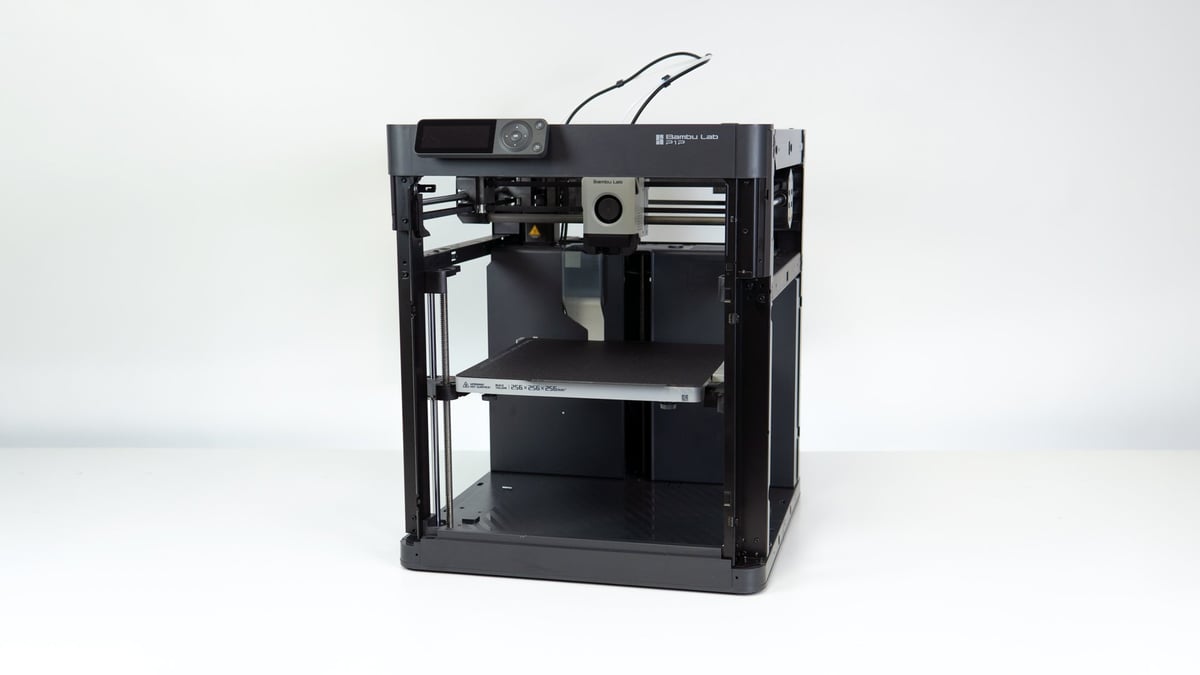
If you can stretch your budget a bit more and want the best beginner 3D printer experience you can get, consider the Bambu Lab P1P. At $599, it’s not cheap compared to our other picks. But, it is a stellar system with features well beyond what you’ll find in the average beginner 3D printer – not the least of which is its CoreXY kinematics.
The P1P boasts a 256 x 256 x 256 mm build volume and a direct, dual-gear extruder. Its print bed is a magnetic textured spring steel sheet that can be easily removed to pop finished prints off, and includes a chute to deposit purge material through its back.
Note that purge chute: it’s important because the P1P is compatible with Bambu Lab’s Automatic Material System (AMS) – the full version of the aforementioned AMS Lite – which allows printing with up to four materials in the same job. AMS units can also be chained to offer a whopping 16 materials. Each AMS is an extra addon and will cost you ~$349, but it’s a great option to have in the future once you’re firmly jealous of all the multi-color prints out there. It’s worth noting, if you’ll probably end up getting the AMS anyway, that the enclosed P1S and AMS combo has price parity with the P1P and AMS bought individually.
Though the P1P comes as an open frame, it can, rather uniquely, be customized with an array of decorative side panels to make the printer more your own or even add extra functionality – such as a pegboard space for tools.
The P1P boasts automated bed leveling and vibration compensation routines, which enables the P1P’s best feature: print speeds pushing 500 mm/s (according to Bambu Lab).
The biggest hindrance to the P1P is its dramatically dated screen. But, with network connectivity and excellent companion software on both mobile devices and computers, there’s little reason to bother with the 2000s-era MP3-player-looking thing that’s tacked onto the front of the machine. In fact, should you run into any problems while using the P1P, you can submit a support ticket directly through the companion app, saving you the trouble of snooping out a support email address or working your way through a chatbot.
It’s no coincidence that the P1P has been our pick for the best 3D printer under $1,000, only bested by its enclosed, but slightly more expensive, sibling, the P1S. The P1P’s advanced features and smooth operation make it ideal for beginners and 3D printing veterans alike.

With the changing market and options available within it, we’ve had to reconsider how price impacts a maker when choosing their first 3D printer. Ultimately, we’ve decided a list of the best beginner 3D printers is most effective by representing a simplified experience with a heavy emphasis on low-cost machines to reduce the barrier to entry. If money is no object and you want the best of the best, more general lists might serve you better.
If that is what you’re looking for, the more expensive options from Bambu Lab enhance the printing experience further than even the excellent P1P. For just $100 more, the enclosed Bambu Lab P1S builds on the P1P’s printing capabilities by enabling reliable performance with temperature-sensitive materials like ABS, and the (significantly more expensive) X1-Carbon adds a much better touchscreen UI, a better hardened-steel nozzle, and a handful of other quality-of-life improvements.
On the other hand, if the A1 Mini is close to what you’re looking for but just too darn small, consider the recently released Bambu Lab A1. It’s a Cartesian-XZ-head bedslinger that works as well as we’ve come to expect from Bambu Lab. At $399, it sits at a price point between the A1 Mini and P1P, making it ideal to meet personal preferences regarding cost and size. And, if multi-material printing is something you’re after, its AMS Lite combo comes in at $40 less than the price of the P1P alone.
The new Ender 3 V3 SE was a real contender for our top pick. At just $199 for a bedslinger with a fixed bed, auto leveling and offset, and dual Z-axis motors, it’s a very accessible printer with the most crucial of modern features. Creality is also making strides in its efforts to create a seamless printing experience through Creality Print and Creality Cloud, something the V3 SE largely misses out on thanks to its lack of Wi-Fi and Ethernet. We also did experience some odd hiccups with the V3 SE’s leveling that forced us to factory reset the printer before it would be remedied. Being an Ender 3, though, the machine will lend itself more to tinkering and benefit from a wealth of advice and mods online – though not all will apply to this model. It’s worth considering over the more appliance-like Bambu models if you want to get your hands dirty modding the printer.
We had to consider the new Original Prusa MK4 when writing this list. There is no comparison for Prusa’s detailed documentation, and its new Nextruder creates perfect first layers every time – taking one of the steepest early learning curves for prospective printers out of the equation. Though the process is very involved, the MK4 is also one of the only modern 3D printers available in true kit form, where users build up their 3D printer from a box of parts. There’s no better way to gain an intimate understanding of how a 3D printer works than by assembling one yourself – and it’ll save you $300 on the MK4’s pre-assembled price. Unfortunately, the MK4 is still very pricey at $1,099 and comes at a time when bed slingers are falling out of vogue. It’s still a stalwart choice, but its unique position of having one foot stuck in the past, while good for some, sees it excluded from many lists – including this one.
Prusa also offers the Original Prusa Mini+, a cantilever 3D printer, at a lower price. Though it’s a bit dated, the system still receives updates adding new features and recently gained input shaping, enabling much faster printing. It comes with Prusa’s excellent support and documentation, produces cracking prints, and is very easy to use. But, between grief with its Bowden extruder system and the $429 price tag in kit form, it falls a little short by today’s standards.
Our former Top Pick, the Sovol SV06, is mostly an Original Prusa MK3S+ at a $195 price tag. As such, it benefits from much of the knowledge around the system it’s based on – one of the most popular 3D printers there’s been – and received high praise in its own right. But, like the system it’s based on, it’s been surpassed in simplicity and extra features for the price.
This article is updated periodically to provide the most up-to-date buying advice we can offer. Here’s what’s happened in the last 12 months:
Update – January 25, 2024: With Bambu Lab launching its seamless software experience on a truly budget bed slinger (and with our editors recommending the machine to friends and family since) it was a no-brainer to replace the Sovol SV06 in this list. Semi-assembled machines are on their way out, it seems. We also took the opportunity to update our Other Machines section and change our How to Pick a Beginner 3D Printer section to better reflect the current market.
Update – July 29, 2023: We popped in to add some 3D printers to this list that have been major successes within the community – and we think they offer the right stuff for people just getting into the hobby. The Sovol SV06, a stellar Prusa MK3S+-like printer, has replaced the Anycubic Kobra as our Top Pick. The two printers have a lot of feature parity, but the SV06’s hands-off calibration makes it too good to ignore – even though it’s a little more expensive. Our former Budget Pick, the Voxelab Aquila, has been replaced by the affordable cantilever Kingroon KP3S 3.0. We missed the first boat on this fan-favorite 3D printer but, having finally gotten it in for testing, love the unique hardware and upgradability.
Update — March 21, 2023: The Voxelab Aquila has been discontinued, it is survived by the Aquila X2 — which we’ve replaced it with on this list. A simple slot-in, it’s pretty much the same printer with a few added perks like a nicer screen and a filament sensor to justify the small price increase. We’ve also updated the upgrade pick, formerly the Prusa MK3S+, because — though still a great printer all-around — it just doesn’t beat the competition in terms of value to a beginner anymore. It’s been replaced by Bambu Lab’s stellar P1P CoreXY 3D printer, which packs a ton (though not all) of the features from the manufacturer’s more premium X1 for less money than our previous pick.
If there’s one thing that testing a lot of 3D printers has taught us, it’s that maintaining a broad benchmarking scheme for 3D printers is impractical for getting a sense of what a 3D printer is like to use and live with. Holding a sub-$200 self-assembled printer for hobbyists to the standard of a $6,000 production machine designed to handle engineering-grade materials won’t tell you that the former is a breeze to set up and the latter a tangled web of firmware updates, buggy systems, and unreliable performance.
We want our reviews and buyer’s guides to cut straight to the chase. What is it like to use a printer? What are the defining features like? What didn’t we like? And, more importantly, is it worth the money? We don’t want to get bogged down benchmarking numbers out of context or hung up on issues affected by more variables than we can control.
Our buyer’s guides and reviews take the intended end user of a 3D printer into consideration. We imagine what they’re likely to do with it and focus the testing on challenging this. If we have a large-volume printer, for example, we’ll be printing – surprise, surprise – large prints, making use of the entire bed, and checking the performance at the limits of Z-height.
Other points of consideration for what makes the best 3D printer include ease of use, supporting software, and repair options. If something goes wrong, how easy is it to fix the machine? Does the documentation or customer service provide adequate information?
We strive to answer all these questions and more in our quest to find the best 3D printer for you.
Trust is important to All3DP, so our product testing policy is strict. When sourcing test units from a manufacturer, we do so under a zero guarantees policy. We make no guarantee of coverage in exchange for the printer, and the first time a manufacturer sees what we think is when we publish the content.
If a manufacturer doesn’t reclaim the unit after testing is complete, it is donated to a local cause or goes into deep storage for responsible disposal later. We occasionally buy machines for testing, too. In such cases, machines purchased by All3DP either remain in the office for team usage or are donated or disposed of in the manner described above.
Manufacturers or benefactors donating units for review do not influence the outcome or content of the reviews we produce. To the best of our ability, we will investigate abnormal issues with the manufacturer to glean better context or get insight into their awareness of the problem. But we make no excuses for poor design or bad QA.
One method we monetize our content at no additional cost to the reader is through affiliate product links. If you click on a shopping link featured in our buyer’s guides and reviews, we may receive a small commission from the store if make a purchase. This is at no additional cost to you. For more meaty content policy details, we cover it all in the advertising and commercial activities section of our terms of use.
For most readers, our top recommended 3D printers are your best bet in a given category.
But, facing the fact that there is no one-size-fits-all solution to home 3D printing, we’re here to help. Here are some pointers to orient you in this terminologically dense but wonderful world. (A word on terminology, we have a handy glossary of terms to know at to bottom of this article.)
Many 3D printers pitched for “beginners” or children go to such lengths to baby the user that they quickly become claustrophobic experiences. You will encounter more limitations than possibilities as your experience grows. If you aren’t satisfied with a “beginner” 3D printer’s features, we’d recommend a budget pick instead. You’ll save a little money, and the opportunity to learn by doing is far greater. And if something goes wrong, there are giant tribes online for each printer that have already asked and answered every question under the sun.
While the general quality of budget 3D printers has dramatically improved in recent years, quality control is often lacking. While manufacturers with large user bases are adapting to meet the demands of their newfound fans, including better customer support, there are usually better wells of knowledge to be found in the owners themselves, who contribute to the vast forum knowledge bases for some 3D printers.
We have zero obligation to manufacturers to sugarcoat what we find, and the first time they read it is when you do too. That’s why you can trust our reviews. We don’t pander to anyone, and our experience with the printer is what you read on the page.
If you can’t find any information about a printer you’d like to know more about, let us know at editors@all3dp.com.
A 3D printer for the home is rarely ever a one-and-done investment. Besides the continual purchase of materials, maintenance costs on perishable printer parts can stack up – think nozzles on an FDM printer or FEP film on an MSLA machine. Of course, parts can wear down or break, too, meaning sourcing replacement parts is a sensible consideration if you plan to print long-term. Printers with roots in the RepRap movement and open-source designs will be easiest to source parts for, with off-the-shelf components part and parcel of the design ethos behind them. Enclosed-design printers aimed at beginners may offer the gentlest introduction to printing, but your options to source spare parts will often be limited to the manufacturer. That’s if you can even get to and diagnose the problem.
The thrill of a new hobby will only sustain you so far. Being the desktopification of an otherwise complicated manufacturing process, expect to encounter, sooner or later, problems with a home 3D printer – even the occasional show-stopping issue. Having an end goal in mind for your printing gives you purpose and a reason to learn the solutions to the problems. Printing simply because it looks cool will result in a small mountain of useless doodads and, eventually, disinterest at the hands of cost, frustration, and the buildup of useless plastic trash.
Most home 3D printers are single extrusion fused deposition modeling machines, meaning a single printable material extruded through a single nozzle. Versatile enough for many applications through material compatibility, they’re safe machines to start with. But if you know you need to print objects with challenging geometries or semi-enclosed volumes, a dual extrusion printer would make your printing far easier. Likewise, single objects that need to have different material properties will only be achievable with dual extrusion. A resin printer will be the way to go for high-detail miniatures. Understand the technologies to find a printer that best suits your needs.
While the size of FDM 3D printers can vary greatly, the spillover is small. You’ll get some emissions from the filament melting, cloying the air, making it inadvisable to spend prolonged periods nearby. Generally speaking, the cleanup is minor and relatively easy to contain, depending on the models you print.
Resin 3D printing, however, is dramatically different and has unique demands that should make you think twice before investing. To varying degrees, the resin is smelly and toxic to you and the environment. It requires dedicated cleanup stations and personal protective equipment. You typically need 95 %+ isopropanol to clean prints and dissolve uncured resin from surfaces.
All printers should be operated in well-ventilated spaces, but this applies doubly to resin 3D printers.
While many excellent 3D printers have gotten their big break on Kickstarter, there’s the unavoidable issue that the platform is not a store. You are not buying a printer when you commit money to a campaign on Kickstarter; you are backing a vision. It’s putting money into the pot to help a company or person trying to achieve something.
You get nothing in return if a project is grossly mishandled and the money disappears. Often what you do get is the beta version of the product. You are paying for early access and all the wrinkles across all stages of the product that come with it.
We’re seeing more big-name companies turning to Kickstarter than ever to launch their products – it’s a safe way for them to gauge demand and drum up some interest against the pressure of a ticking countdown. Despite many companies being capable of outright launching products, they go cap-in-hand to enthusiasts with the promise of shiny new tech. Don’t be that user unless you absolutely must be the first to use a product and have money you can afford to lose.
We don’t think it’s worth the risk, but in the interest of cool new tech, report on new campaigns with our news coverage. You will never see a Kickstarter 3D printer in our buyer’s guides unless it has completed its campaign and the printer is widely available at retail, with all the protections that come with buying from a store.
But where’s the UltiMaker? Or Formlabs? What about Raise3D? Desktop Metal?
In the past, we’d list the best professional 3D printers alongside what we consider consumer or hobby-oriented machines (the printers we mainly focus on). An apples and oranges comparison, we know.
With this in mind, we created All3DP Pro, a wing of our content exclusively covering the professional applications of 3D printing and additive manufacturing solutions. Here’s a selection of articles covering the best 3D printers for professional use to get you started.
Choosing the best 3D printer is tricky, not least because the terminology surrounding 3D printing is dense. Here are some need-to-know terms, their explanations, and useful links to help you on your way to 3D printing mastery.
FDM: Fused deposition modeling, otherwise known as FDM, is a 3D printing process that extrudes heated thermoplastic material through a moving nozzle to build an object layer by layer. FDM is a trademarked term, which led to the RepRap open-source movement to coin the alternative phrase “fused filament fabrication” (FFF), but the two are interchangeable.
Filament: Filament is the base material used to 3D print objects via FDM. The filament is typically a solid thermoplastic fed to a print head, heated to its melting point, and extruded through a small nozzle. Filament is commonly available in spools of either 1.75 mm, 2.85 mm, or 3 mm diameter widths – dimensions that dictate the printers that can use them.
G-Code: G-code is the machine language used to instruct computerized tools such as 3D printers. Giving coordinates and instructions for tool heads and other non-movement functions, it is almost exclusively generated by slicing software. It comprises a library of commands to control specific actions like motion, speed, rotation, depth, and other related switches and sensors used in a machine’s operation. You can get to grips with G-code in no time with our guide to G-code commands.
Heated bed: This is a build plate that is heated so that the few layers of extruded plastic are prevented from cooling too quickly and then warping. A heated bed is essential for working with ABS or PETG materials but not so much with PLA.
Hot end: This is the cluster of components that heat and melt the plastic for deposition through the nozzle.
Extruder: Used by some to describe the entire system of parts that pushes and melts filament, extruder can also refer specifically to the motor and accompanying gears that grip the filament, feeding it to the hot end. How the extruder is arranged can affect the printer and its capabilities. There are two common arrangements: Bowden and direct. It’s a messy subject with overlapping terms and technical explanations; our guide to 3D printer extruders gives you all the knowledge to make sense of it.
Bowden: A style of extruder that sees the extruder motor positioned away from the hot end – typically the structural frame of the printer or on one end of the X-axis gantry. So-called for the Bowden cable and its action of allowing a wire to move freely within tightly constraining tubing, the Bowden extruder feeds filament through a PTFE tube directly into the hot end.
Direct Extruder: The other commonly seen extruder type, a direct extruder sees the extruder motor and associated feeding mechanism mounted directly to the hot end, with barely any distance between the feed and the melt zone of the hot end.
Dual Extrusion: Some 3D printers carry two extruders/hot ends, allowing them to incorporate multiple colors or materials into the same print job. While the obvious appeal comes from the possibility for decorative two-tone prints, the real benefit of dual extrusion systems is combining different materials, such as dissolvable support material, to enable the printing of otherwise impossible geometries. It’s a deep topic worth exploring more in our guide to all you need to know about dual extrusion.
PLA: Polylactic Acid, otherwise known as PLA, is a thermoplastic commonly used as a material for printing with FDM 3D printers. It’s easy to work with and is available in many colors and finishes. PLA is somewhat brittle – don’t expect to print strong items with it – but it remains popular for decorative printing thanks to its low cost. You can learn more about PLA in our guide dedicated to the topic.
SLA: Stereolithography is a 3D printing technology that falls under the broader process of vat photopolymerization. The term is often (incorrectly) used to describe all methods of vat polymerization – really, it’s a particular technology that uses a directed laser beam to trace layers into a vat of liquid photopolymer resin. Alongside SLA, other technologies are considered vat polymerization.
Resin: The material used in desktop SLA, DLP, and LCD (MSLA) 3D printers. A blend of chemicals that includes a photoinitiator, resin solidifies under ultraviolet light. Highly toxic and difficult to clean up after a spill, care, attention, and personal protective equipment are musts when working with resin. It is an unpleasant material, and wastage must be disposed of in accordance with local laws. Despite all the warnings, it’s the only way to go for intricate detail.
LCD 3D Printer: A common term for resin 3D printers that use an LCD as a layer mask over UV light. The de facto standard in inexpensive resin 3D printers, the technology is cheap and widely used. The LCD panels are consumable, though, with monochrome LCDs typically having lifespans in the low 1,000s of hours.
MSLA: Mask stereolithography (MSLA) is a term coined by Structo but popularized by Prusa Research. It refers to, basically, the LCD 3D printer as described above.
Micron: One-thousandth of a millimeter. This unit of measurement is commonly used in 3D printing as a value to indicate accuracy, resolution, or surface finish.
Slicer: 3D printing works by building an object layer by layer. A slicer is a program that divides a 3D model into flat layers and generates the machine code for the printer to trace out said layers. The output of a slicer for FDM 3D printers is typically G-code, which gives instructions and coordinates for the printer to execute. Our deep dive explaining what exactly a slicer is gives good foundational knowledge. Many popular slicers are free and open source. Others are proprietary and machine-specific. It’s an essential tool for successful 3D printing.
STL: STL is the most popular file format for 3D printing. Developed by 3D Systems in the ’80s, the STL file type only contains the surface geometry of a 3D object. Despite industry efforts to move onto more efficient and data-rich formats such as 3mf, STL endures and is the most commonly found 3D model file type on popular 3D model file repositories. We explain in more detail in our guide to what exactly STL is.
Open Source: The term given to a product, typically software, but also applicable to hardware that is freely open for others to modify and redistribute according to their needs. In 3D printing, this is often in the spirit that individuals are free to modify, improve, and share changes to the source material for others to test, iterate, and reciprocate. Open source licenses govern the fair and correct usage of open source works, giving terms and conditions that ensure the freedom of access to the creation and any derivatives.
RepRap: A project started in 2005 by Dr. Adrian Bowyer, a mechanical engineering lecturer at the University of Bath. Created to develop a replicating rapid prototype, a low-cost machine capable of printing replacement parts for itself or other new machines. The vast majority of desktop 3D printers stem from the work laid down by the RepRap project. We have a fascinating alternative RepRap Wiki page on the topic if you want to dig deeper.
License: The text of "The Best 3D Printers for Beginners in 2024" by All3DP is licensed under a Creative Commons Attribution 4.0 International License.
CERTAIN CONTENT THAT APPEARS ON THIS SITE COMES FROM AMAZON. THIS CONTENT IS PROVIDED ‘AS IS’ AND IS SUBJECT TO CHANGE OR REMOVAL AT ANY TIME.